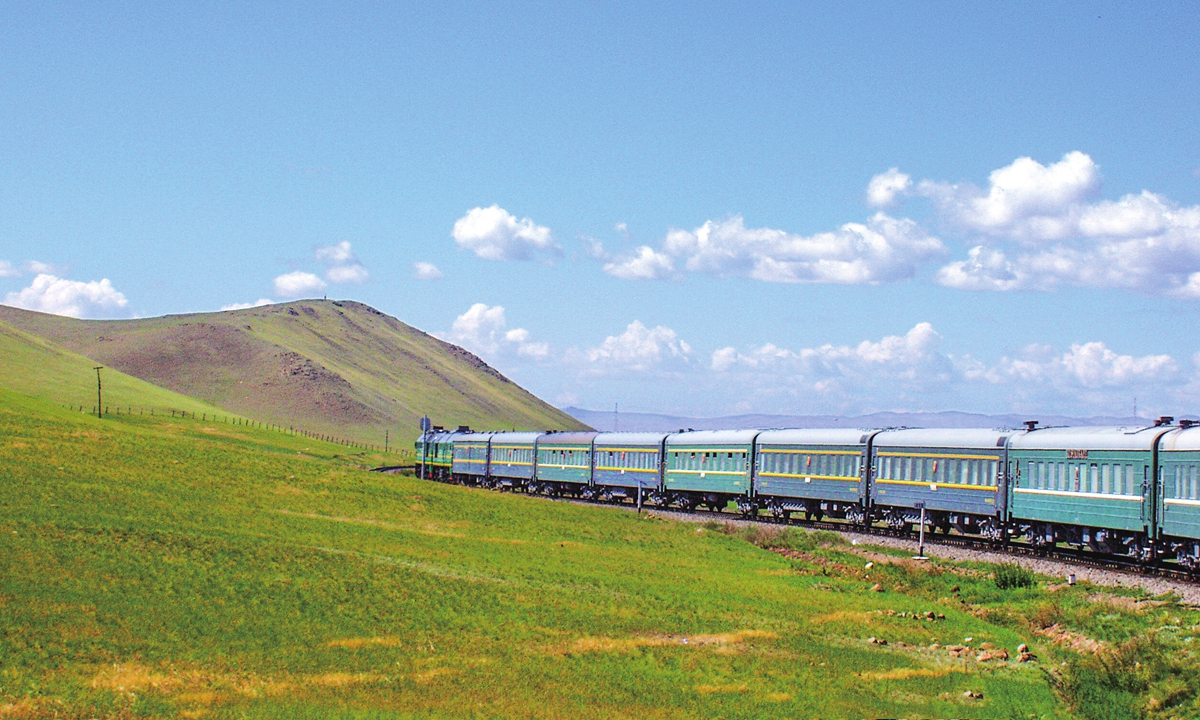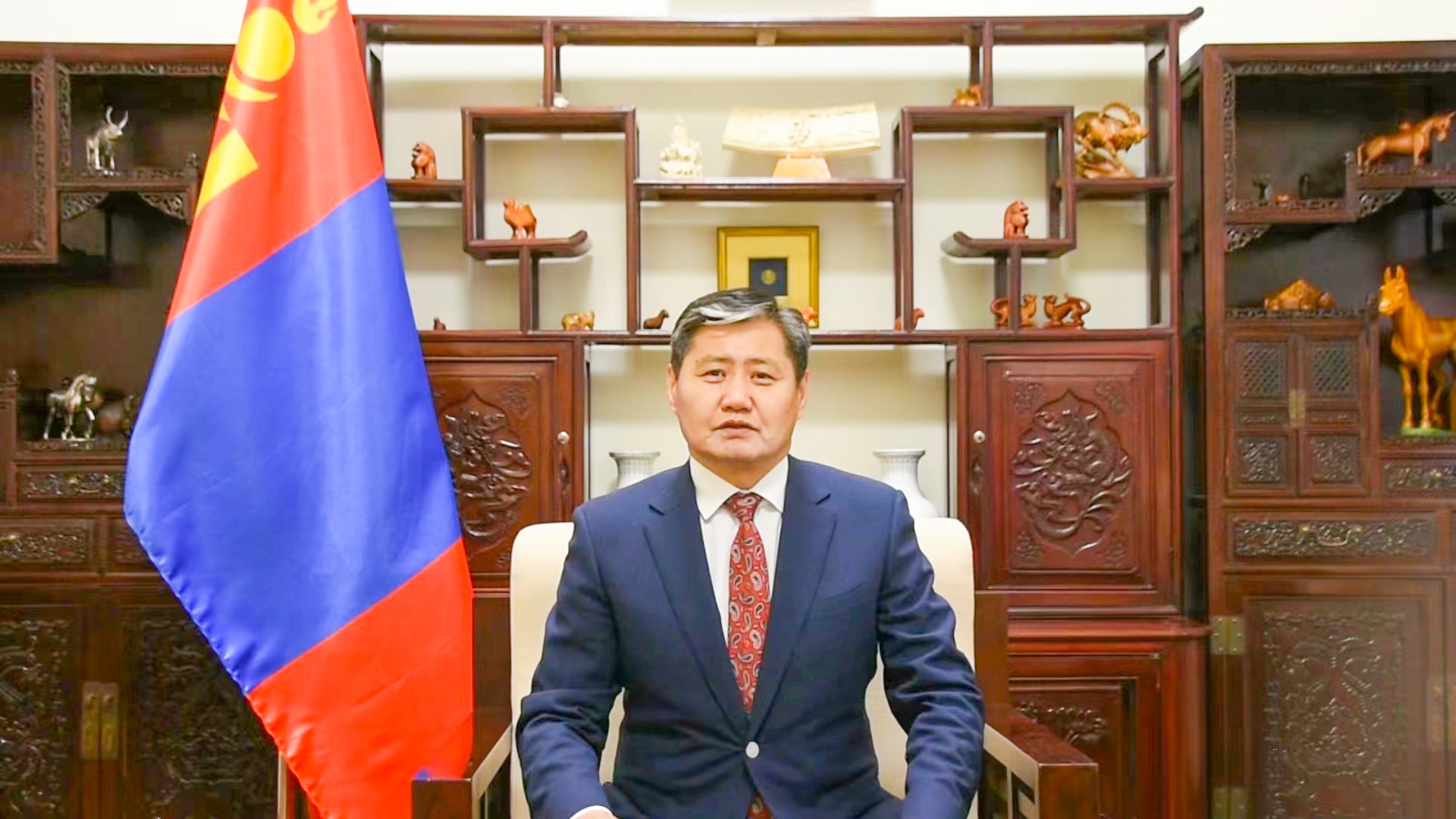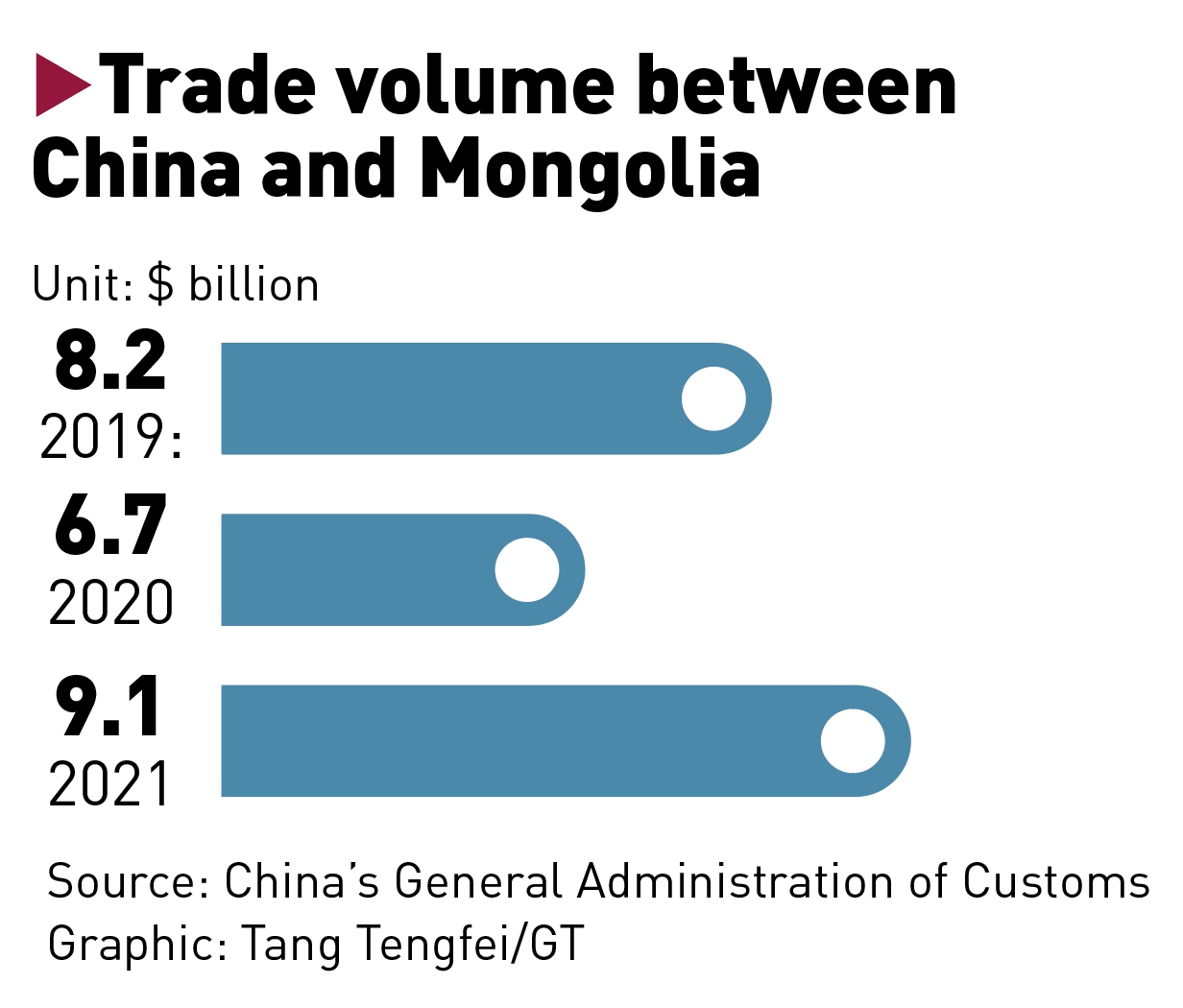
A train running in Mongolia Photo: VCG
Editor's Note:Mongolia and China share a border of more than 4,700 kilometers, and both countries are strategic partners and friendly and good-neighboring countries, exemplified by the fact that China has been Mongolia's largest source of investment and trading partner for 18 consecutive years. On September 15, the heads of China, Mongolia and Russia extended the Outline of the Development Plan on Establishing the China-Mongolia-Russia Economic Corridor by five years in Samarkand, Uzbekistan, unleashing greater potentials for the regional prosperity while upgrading Mongolia's role as a transit hub between the East and the West.
Changes have already taken place for Mongolia with trade and economic cooperation with China coming to a historic high under the Belt and Road Initiative (BRI). As Mongolian Ambassador to China Tuvshin Badral (
Badral) said, "the BRI is expected to help alleviate the difficulties brought about by Mongolia's landlocked geographical location, and it will also play an important role in bringing more economic opportunities to the region and beyond."
In an exclusive interview with Ambassador Badral, he shared with Global Times reporter Yin Yeping (
GT) how the Mongolian side believes that the BRI proposed by China can deepen cooperation and contribute to the development of the region and beyond.

Mongolian Ambassador to China Tuvshin Badral Photo: Courtesy of embassy
GT: What are your expectations to the 20th National Congress of the Communist Party of China (CPC) that is due to be convened on October 16? Badral: First of all, I wish the 20th CPC National Congress a successful convening. The 20th CPC National Congress will unite and lead all parties, ethnic groups and people to develop continuously, and will comprehensively summarize the great and valuable achievements in the development and maintenance of socialism with Chinese characteristics, with detailed analysis of international and domestic situations. Therefore, we are confident that the 20th CPC National Congress will be a complete success.
Over the past decade, China has solved the problem of extreme poverty and achieved its century-long goal of building a moderately prosperous society in all respects. I think that says enough of the great achievements made in this period.
Mongolia has also made important achievements and accumulated rich experience in ensuring sustainable socio-economic development. The Chinese government attaches great importance to the development of Mongolia-China relations, and sharing development achievements with neighboring countries is an important driving force for the development and cooperation of Mongolia-China relations. Therefore, I believe that after the successful convening of the 20th CPC National Congress, Mongolia-China relations will continue to develop, benefiting both countries and peoples.
GT: In your perspective, how would the upcoming congress chart China's economic development in the next five years? What would be the focal points?
Badral: The top leadership is of great significance to China's economic development in the next five years. I believe that China's economy will further develop and see more prosperity. I believe that China's high-quality economic development in the next five years will make significant contributions to the realization of the long-term goal of basically realizing socialist modernization by 2035 and the goal of turning to be a great modern socialist country that is prosperous, strong, democratic, culturally advanced, harmonious, and beautiful in the middle of this century.
As a friendly and good neighbor of China, Mongolia hopes that China's economic development will continue to rise. Mongolia is willing to work with China to deepen the connection between the "Steppe Road" plan and the Belt and Road Initiative, Mongolia's "New Revival Policy" and the "Global Development Initiative," and thus creating the development engine of our bilateral relations. We firmly believe that China's development will benefit more neighboring countries including Mongolia and achieve common development and prosperity in the world.
GT: The leaders of China, Mongolia and Russia held their sixth meeting in Samarkand, Uzbekistan on September 15. The three parties confirmed the extension of the Outline of the Development Plan on Establishing the China-Mongolia-Russia Economic Corridor by five years. Can you talk about the significance of the corridor to Mongolia's economic development and bilateral trade with China?
Badral: The China-Mongolia-Russia Economic Corridor is an important part of the Belt and Road Initiative. On June 23, 2016, during the third meeting of the three leaders in Tashkent, the outline of the construction of the China-Mongolia-Russia Economic Corridor was signed.
On September 15 this year, during the SCO Summit held in Samarkand, Uzbekistan, the leaders of Mongolia, China and Russia exchanged views on the economic corridor to be implemented under the framework of the Belt and Road Initiative and extended the implementation plan of the economic corridor for five years.
The construction of the Economic Corridor aims to further strengthen trilateral cooperation between China, Mongolia and Russia by increasing trilateral trade volume, enhancing product competitiveness, strengthening transit transport facilitation, and developing infrastructure through cooperation projects.
The tripartite "planning outline" includes 32 projects in the fields of transportation infrastructure development and interconnected highways, railway corridors, cross-border transport development, production capacity cooperation, improving customs supervision, energy, tourism, environmental protection, customs cooperation, education, science and technology, people-to-people and cultural exchanges, and agriculture. The construction of China-Mongolia-Russia Economic Corridor will play an important role in expanding Mongolia-China trade, promoting Mongolia's economic development and improving people's livelihood.
GT: Also at the summit, the three sides officially launched a feasibility study on the upgrade and development of the middle-line railway of the China-Mongolia-Russia Economic Corridor. Can you tell us more about the middle-line railway?
Badral: The three sides jointly issued the "Joint Statement on Launching the Feasibility Study on Upgrading and Developing the Middle Line Railway Corridor" in Samarkand and agreed to launch the "Work Plan for Feasibility Study on Upgrading and Developing the Middle Line Railway Corridor."
At present, 82 transport lines have been opened for China-Europe freight trains. In 2021, the total number of trains between China and Europe reached 15,183, an increase of 22 percent year-on-year, and the number of trains passing through Mongolia has also increased steadily. Based on its unique geographical location connecting Asia and Europe, Mongolia is committed to becoming a "Transit Mongolia" hub for trade, tourism, transport and logistics networks, freight transport and services. Therefore, the expansion of China-Europe railway transportation is in line with the above objectives.
GT: The three countries agreed at the summit to actively promote the laying project of the China-Russia natural gas pipeline transiting through Mongolia. Can you disclose the details of the project? If the project is implemented, what benefits will it bring to China and Mongolian trade?
Badral: The Mongolian side attaches great importance to the construction project of China-Russia natural gas pipelines transiting through the territory of Mongolia, and has maintained active interaction with China and Russia on the implementation of this project. Mongolia has actively promoted this project at various settings, including the recent trilateral and bilateral meetings such as the expert level meeting of the "Working Group on Economic Corridor between Mongolia, Russia and China" which was held on November 12, 2021, and the "Mongolia-China Inter-Committee Meeting of Cooperation on Mineral, Energy and Interconnectivity" that was held on November 15, 2021.
Within this framework, on January 21, Mongolia and Gazprom reached an agreement on the preliminary conditions for the feasibility study of the "Russian Gas Supply Pipeline Construction Project from Mongolia to China."
At the recent meeting, China expressed active support for the construction project of a natural gas supply pipeline from Russia to China through the territory of Mongolia which will have a positive impact on the energy security of Northeast Asia.
In this way, the three parties have reached a consensus at the political level, and leave the technical and economic evaluation work for the project implementation team of the parties. After this evaluation, the contribution to Mongolia's society, economy and the economic and trade development of Mongolia and China will be clearer.
GT: On September 9, Mongolia's first heavy cargo railway was completed and opened to traffic. How do you evaluate the significance of the opening of the railway to the promotion of China-Mongolia trade? The opening of this railway also provides a legal basis for the opening of the 2nd railway channel. Can you tell us more about that? Badral: On September 9, the opening ceremony of the railway from Mongolia's Tavan Tolgoi coal mine to Gashuun Sukhait port was held. Mongolian President Ukhnaa Khurelsukh said in his speech, "this is a road of development, investment, and opportunity for Mongolia." In the future, Mongolia will get more and better development with the help of this railway.
In 2021, the two sides successfully agreed on the railway crossing point of the Mongolia-China Gashuun Sukhait-Ganqimaodu border port. At present, Mongolian and Chinese railway agencies continue to implement railway construction in their respective territories, and will connect cross-border railways very soon.
The opening of the railway will shore up Mongolia's ability to export minerals to China and to third countries through Chinese ports, and will lay the foundation for the opening of the second Mongolia-China railway channel in the future.
After the railway is opened to traffic, the annual coal export capacity will reach 15 to 20 million tons, and bring many advantages such as increasing bilateral trade volume, reducing transportation troubles, increasing coal export volume and limiting the risk of cross-border transmission of the COVID-19 epidemic.
As of today, the road transportation cost from Tavan Tolgoi to Ganqimaodu port is about $40 per ton, and the rail transportation cost has dropped to $8, which is five times lower than the current transportation mode. The railway will also create new jobs and development opportunities, with an initial forecast of around 2,000 permanent jobs.
GT: China has been Mongolia's largest source of investment and trading partner for 18 consecutive years. How much do you expect the bilateral trade volume for this year and which commodities will be the boosters of the trade growth?
Badral: At the time of the severe epidemic, due to the close cooperation, both sides have maintained positive economic and trade relations, while ensuring the normal operation of ports. The bilateral trade volume will continue to grow steadily in the future.
The economic relations between Mongolia and China are highly complementary. In the future, according to the long-term development policy, the two sides can deepen the cultivation of mining, processing industry, food, agriculture, energy, tourism, small- and medium-sized industry, transportation and logistics, information technology and other fields.
From January to September, Mongolia's total foreign trade volume amounted $13.35 billion, of which trade with China accounted for 60 percent. The bilateral trade is mainly affected by the epidemic.
Under the condition that epidemic prevention and control measures are taken well and the turnover of goods at border ports is maintained, the bilateral trade volume is expected to exceed $10 billion, surpassing last year's achievements.
Bilateral trade is mainly dominated by mineral products. The increase in the price of mineral products in the world market and the increase in Chinese demand have played a major role in the growth of bilateral trade volume. Affected by the epidemic last year, Mongolia exported about 15 million tons of coal to China. This year, Mongolia plans to increase coal exports.

Trade volume between China and Mongolia Graphic: Tang Tengfei/GT
GT: Mongolia has been an active participant to the construction of the Belt and Road Initiative. How do you evaluate the benefits that the construction of the BRI has brought about to Mongolia's economic and trade development?
Badral: Since the Belt and Road Initiative was proposed in 2013, China has established cooperation with 149 countries and 32 international organizations under the BRI and has implemented a large number of key infrastructure projects, and achieved substantial growth in trade and investment.
Mongolia and China share a border of more than 4,700 kilometers. We are strategic partners and friendly neighbors. China is one of my country's largest trading and investment partners. Through active consultation, the two sides have agreed to align the development policies and goals of the two countries, and signed a memorandum of understanding on the alignment of Mongolia's Steppe Road Program and China's BRI.
The Mongolian side believes that the BRI proposed by China can deepen cooperation in soft and hard infrastructure among countries and contribute to the development of the region and the world. The BRI is also expected to help alleviate the difficulties brought about by Mongolia's lack of a seaport and landlocked location, and it will also play an important role in bringing more economic opportunities to the region and beyond.
GT: Mongolia is sitting on a large amount of rare-earth resources, but due to insufficient technology and other factors, these resources have not been well exploited. China has the world's largest number of rare-earth mining, refining and separation patents. Do you think there is room for cooperation on both sides in the development and utilization of these resources? Badral: Within the framework of bilateral cooperation in the mining sector, we can study and carry out cooperation in this field, especially given the fact that mineral product trade accounts for 70-80 percent of Mongolia-China economic and trade cooperation. Currently, the Mongolian government aims to improve the bilateral trade structure, increasing the volume of final commodity trade, and diversifying product categories.
This year, we have agreed with the Ministry of Commerce of China to revise the Medium-term Development Outline of Mongolia China Economic and Trade Cooperation for the second time. For example, in the next five years, the two sides plan to carry out close cooperation in the field of processing and value-added product industry. The leaders of Mongolia and China have repeatedly encouraged and supported cooperation and exchanges in this regard at high-level meetings.
Mongolia has rich natural resources, while China has advanced technology, manpower, capital and patents. We welcome more Chinese companies and enterprises to invest in Mongolia, develop rare minerals, and cooperate with Mongolia to produce final products.






